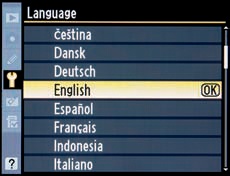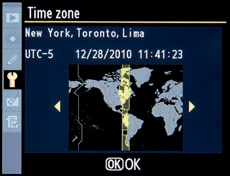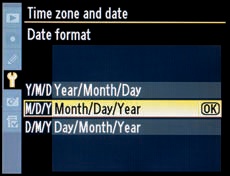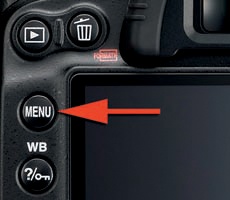Surprisingly, quite a few brand-new DSLR users are buying a Nikon D7000 instead of a lower-cost, entry-level model. Even new users appreciate the robust high quality of the camera.
The upcoming sections and chapters are best read with your camera in hand, ready for configuration. There are literally hundreds of things to configure on this advanced DSLR. In this chapter, I’ll give new D7000 users a place to start. Later, as you progress through this book, we’ll look at all the buttons, switches, dials, and menu settings in detail. That will allow you to fully master the operation of your Nikon D7000.
Each menu in the camera has its own chapter or section. Plus, there is additional information on how to put it all together in chapters like Chapter 8; Chapter 9; Chapter 10; and Chapter 12. Since the D7000 has several movie modes, we’ll cover movies in their own chapter, Live View and Movie Modes.
Although the D7000 is an enthusiasts’ or advanced camera, many brand-new DSLR users have purchased a D7000 as their first digital single lens reflex camera. New users may not know how to attach and remove a lens or battery, and they may need help with inserting, formatting, and using memory cards.
The majority of this book’s readers, however, already know how to perform these tasks. I do not want to ask a more experienced DSLR user to read over the basics of DSLR use, so I’ve created a document called Initial Hardware Considerations, which you can download at:
http://rockynook.com/NikonD7000
There are also several other articles of interest to new Nikon D7000 users on this webpage.
Now, let’s start with the initial configuration of a brand-new Nikon D7000. There are five specific steps you must complete when you first turn on the camera.
This section is devoted to the first-time configuration of the camera. There are certain settings that must be set up immediately (covered in this section) and others that should be configured before using the camera extensively (covered in the next section, Camera Functions for Initial Configuration).
I’m not going to go into detail on all possible settings in this chapter. That is reserved for the individual chapters that cover the various menus and functions. Instead, I’ll walk you through five steps for first-time configuration of the camera. In the next section I’ll refer you to the chapter sections and page numbers in this book that provide the screens and menus for each function that should be configured before using the camera for the first time. Later chapters will cover virtually all camera settings.
When you first insert the battery into a factory-fresh Nikon D7000 you will notice that the word CLOCK flashes on the camera’s upper LCD Control panel. If you don’t see CLOCK flashing, then your camera has already been set up for initial use.
Let’s examine how to configure a new camera. You’ll see the following five screens when you first turn the camera on, and they must be set up immediately.
The D7000 is multilingual or multinational. As partially shown in Figure 1-1, the menus can be displayed in 22 languages. Most likely the camera will already be configured to the language spoken in your area since various world distributors have the camera somewhat preconfigured. The following is a list of the display languages available in the D7000, firmware version A1.00, B1.00, L1.002 (Setup Menu > Firmware version):
Czech
Danish
German
English
Spanish
French
Indonesian
Italian
Dutch
Norwegian
Polish
Portuguese
Russian
Finnish
Swedish
Turkish
Arabic
Traditional Chinese
Simplified Chinese
Japanese
Korean
Thai
Here are the steps to select your language:
Refer to Figure 1-1 for the Language list the camera presents on startup.
Use the circular Multi Selector—with arrows pointing left, right, up, and down—to scroll up or down until your language is highlighted.
Press the OK button to select your language.
The camera will now switch to the second screen in the setup series, the Time zone screen.
This is an easy screen to use as long as you can recognize the area of the world in which you live. Use the map shown in figure 1.12 to find your area, then select it. Here are the steps to select the correct Time zone for your location:
Refer to Figure 1-2 for the Time zone screen you’ll use. You’ll see yellow arrows pointing to the left and right on either side of the small black and gray world map.
With the Multi Selector, scroll to the left or right until your world location is highlighted in yellow. You will see either a vertical yellow strip or a tiny yellow outline with a red dot. At the top of the screen below the Time zone words, you will see the currently selected Time zone. Mine is set to New York, Toronto, Lima (UTC-5), as shown in Figure 1-2.
Press the OK button, and your Time zone will be locked in place.
The camera will now present you with the next screen in the series, the Date format screen.
The English-speaking world uses various date formats. The Nikon D7000 allows you to choose from the most common ones. There are three date formats you can select (Figure 1-3):
Y/M/D – Year/Month/Day (2010/12/31)
M/D/Y – Month/Day/Year (12/31/2010)
D/M/Y – Day/Month/Year (31/12/2010)
American residents usually select the M/D/Y Month/Day/Year format. However, you may prefer a different format. Here are the steps to select the date format you like best:
Refer to Figure 1-3 for the Date format screen you will use.
Using the Multi Selector, scroll up or down to the position of the date format you prefer.
Press the OK button to select the format.
When you have the Date format selected, the camera will switch to the Daylight saving time screen.
Many areas of the United States observe daylight saving time. In the springtime, many American residents set their clocks forward by one hour on a specified day each year. Then in the fall they set it back, leading to the clever saying, “spring forward and fall back.” To enable automatic Daylight saving time, follow these steps:
Refer to Figure 1-4 for the Daylight saving time screen you will use.
There are only two selections: On or Off. Choose the one you prefer by scrolling with the Multi Selector.
Press the OK button to select your choice.
If you set Daylight saving time to On, your D7000 will automatically spring forward and fall back, adjusting your time forward by one hour in the spring and back one hour in the fall.
Now that you’ve made the Daylight saving time decision, the camera will move on to the last screen in the series of five, the Date and time screen.
My Recommendation: If you live in an area that observes daylight saving time, it’s a good idea to set your camera to make this adjustment automatically. I always leave Daylight saving time set to On. Why not let the camera remember to change the time twice per year?
This screen allows you to put in the current Date and time. It is in year, month, day (Y, M, D) and hour, minute, second (H, M, S) format.
Here are the steps to set the Date and time:
Refer to Figure 1-5 for the screen you’ll use.
Using the Multi Selector, scroll to the left or right to select the various date and time sections. Scroll up or down to set the values for each one. The time values use a 24-hour clock, or military time. Use the 12- to 24-Hour Time Conversion Chart to convert the 12-hour time you are probably using (for example, 3:15 p.m. equals 15:15).
Press the OK button when you’ve finished inputting the Date and time.
Please note that the time setting uses the 24-hour military-style clock. To set 3 p.m., you would set the H and M settings to 15:00. As mentioned, there is a 12- to 24-Hour Time Conversion Chart for your convenience.
To access the various configurable menus in the D7000, you’ll use the MENU button found on the back of the camera near the top left of the Monitor. Please remember the location of this button since it will be used often in this book (Figure 1-6). To avoid unnecessary repetition, I won’t mention that you need to press the MENU button to get into the camera menus in the upcoming chapters.
There are six primary menu systems found in the camera, and this book has a chapter devoted to each one. Let’s take a brief look at the opening screens of the six menus, shown in Figure 1-7. You get to these six menus by pressing the MENU button and scrolling up or down with the Multi Selector. A selector bar with tiny icons appears on the left side of the Monitor when you press the MENU button. You can see it at the left of each of the menus in Figure 1-7.
As you scroll up or down in the selector bar, you’ll see each menu appear with its icon highlighted in yellow—one at a time—to the right of the bar. The name at the top of the menu will help you figure out which one you are currently using.
The six menus that are found in the D7000 menu system are, in order, as follows (Figure 1-7):
Playback Menu
Shooting Menu
Custom Setting Menu
Setup Menu
Retouch Menu
My Menu or Recent Settings
Notice that My Menu can be toggled with an alternate menu called Recent Settings. These two menus can’t be active at the same time. My Menu is much more functional for most people, so it is shown in Figure 1-7. The chapter titled Chapter 7 covers both of them in detail so you can choose which one you want to appear most of the time on your camera. My Menu allows you to add the most-used menu items from any of the other menus to your own personal menu, and Recent Settings shows you the last 20 menu items you’ve changed.
The following is a list of functions that you may want to configure before you take many pictures. These set up the basic parameters for camera usage. Each function is covered in great detail on the page number shown, so I did not repeat the information in this chapter. Please turn to the indicated page and fully configure the function, then return here and move on to the next function. When you are done, your camera will be ready for use. Place a bookmark here since you’ll refer back to this chapter for each configuration item.
Format memory card – Format Memory Card (format your memory cards)
LCD brightness – LCD Brightness
Time zone and date – Time Zone and Date (if not configured earlier in this chapter)
Language – Language
Auto image rotation – Auto Image Rotation
Copyright information – Copyright Information
Shooting Menu
Role played by card in Slot 2 – Role Played by Card in Slot 2
Image quality – Image Quality
Image size – Image Size
JPEG compression – JPEG Compression
White balance – White Balance
Set Picture Control – Set Picture Control
Color space – Color Space
Active D-Lighting – Active D-Lighting
Long exp. NR – Long Exp. NR
High ISO NR – High ISO NR
ISO sensitivity settings – ISO Sensitivity Settings
Movie settings – Movie Settings
Playback Menu
Display mode – Display Mode
Image review – Image Review
Rotate tall – Rotate Tall
Custom Setting Menu
AF-C priority selection – a1 AF-C Priority Selection
AF-S priority selection – a2 AF-S Priority Selection
Live view/movie AF – a8 Live View/Movie AF
Monitor off delay – c4 Monitor Off Delay
Beep – d1 Beep
Viewfinder grid display – d2 Viewfinder Grid Display
File number sequence – d8 File Number Sequence
Flash sync speed – e1 Flash Sync Speed
Assign Fn button – Figure 4-61
Assign AE-L/AF-L button – f3 Assign Fn Button, f4 Assign Preview Button, f5 Assign AE-L/AF-L Button







